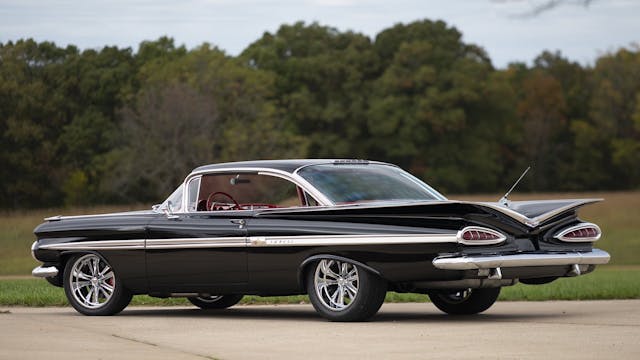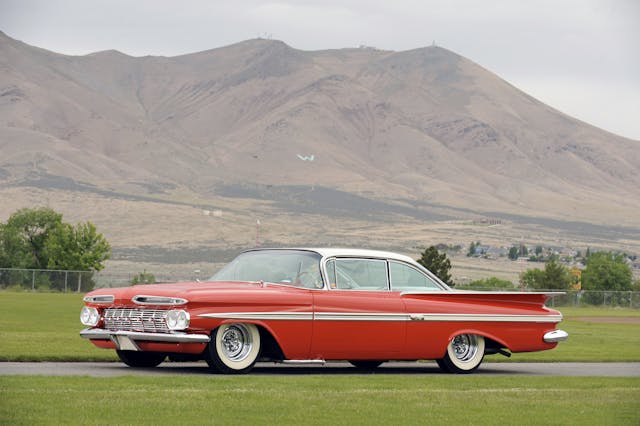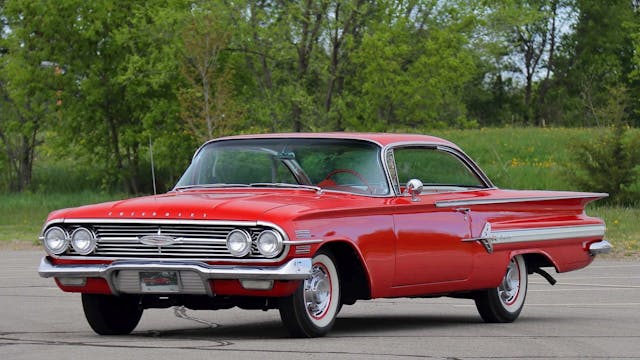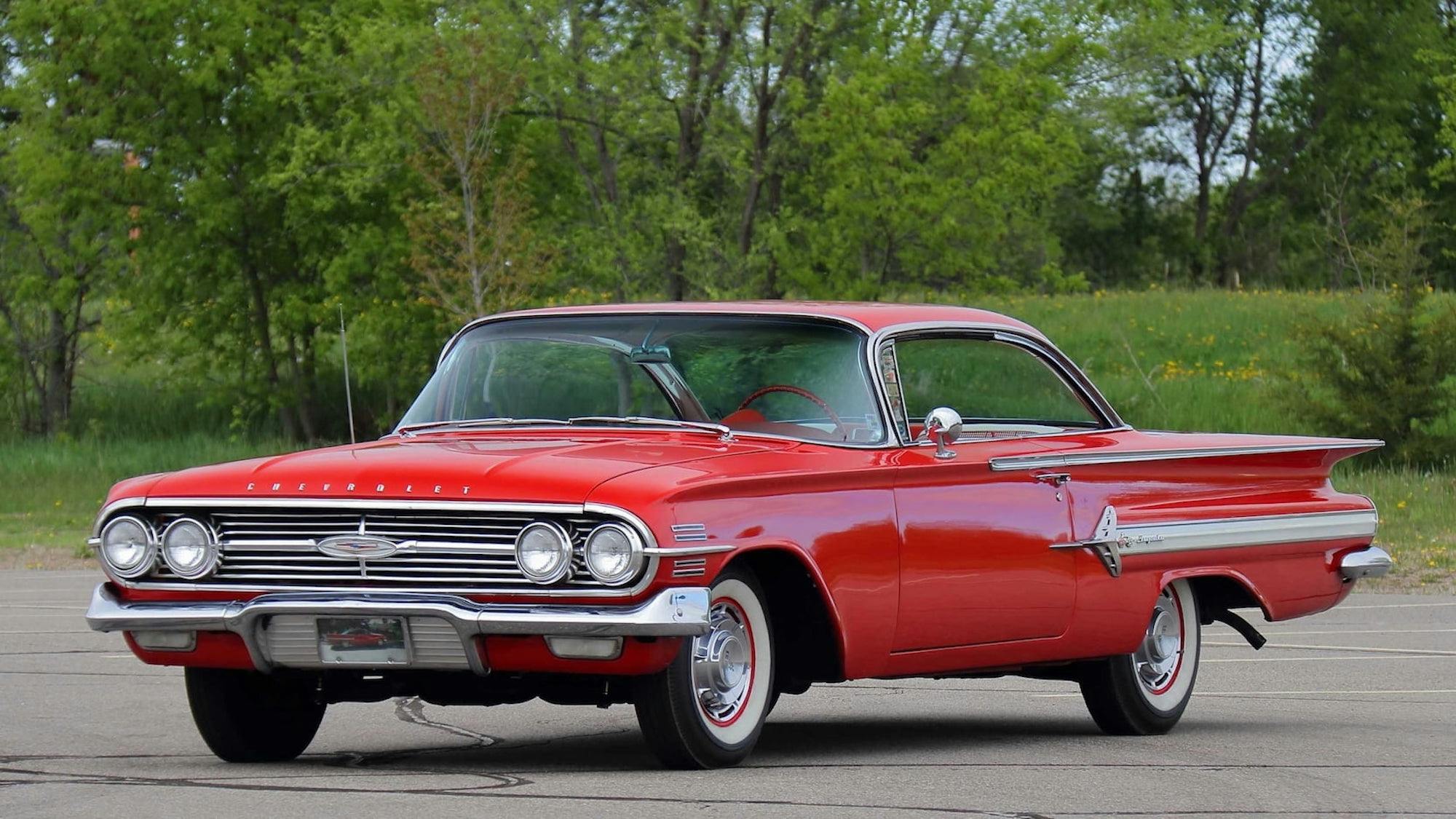Media | Articles
Ever adaptable to changing tastes, the ’59–60 Impala will never fade
There are few classic cars as versatile as the venerable Chevrolet Impala. Sure, it’s generally been an enormous land yacht designed to comfortably carry an American family, but the model quickly found love in drag racing as well as in the custom and lowrider scenes. Its reputation for attainable full-size performance extends over decades of production.
Although you’ll find Impalas of all eras in collectors’ garages, the second-generation (1959–1960) cars are particularly noteworthy for the way they transcend their era and their genre.
While considerably different from their Tri-Five predecessors, the first-gen (1958) Impalas still had one foot in the ’50s from a design perspective. General Motors made big styling changes for 1959, dramatically redesigning models across the board. The Impala, which had been a Bel Air trim in ’58, was now its own model and grew longer, lower, wider, and heavier. The Impala also sported GM’s wide-open greenhouse theme, which featured acres of glass framed by delicate pillars.

While each has its own character, the 1959 and 1960 Chevrolet Impalas have a lot in common. The two years feature the boldest fins to ever grace a Bowtie. Wider than they are tall, the fins are actually restrained relative to many of the flamboyant variations offered by other brands during the late ’50s and early ’60s. The Impala’s still managed to make a statement, though. 1959 models feature gracefully curved fins and prominent, cat-eye taillights, while the 1960 model foreshadows what was to come with more angular, trim fins and simple, round taillights that would become a Chevrolet trademark through 1965.
For performance, second-gen Impala buyers had the option of inline-six, 283-cubic-inch small-block V-8, or 348-cu-in big-block. A 250-hp version of the 348 came with a single four-barrel carburetor, while a triple-carbed version was available that packed 280 hp.
Marketplace
Buy and sell classics with confidence
Racing-minded Chevy buyers had more options still. They could opt for a 305-hp, four-barrel 348-cu-in V-8, which featured a solid-lifter valvetrain and higher compression ratio, or they could go whole-hog and slap three two-barrel carbs on for a then-potent 335 horses.
Chevrolet would wring even more performance out of the third-gen cars, strengthening the 348 engine in 1961 and introducing the fabled 409 as well, giving the bubble-top Impala that followed even more power. Still, ’59 and ’60 Impalas resonate with collectors because they established the nameplate’s performance pedigree and introduced the long, low look for which the model came to be known.

Impalas roam a large swath of geography, although predictably, most are found in sunnier climates. Western and Southern states lay claim to 57 percent of Hagerty-insured Impalas.
You’d think the audience would skew older for a car that debuted when many baby boomers were, well, babies; yet Gen-Xers and younger enthusiasts made up a full 54 percent of people calling Hagerty for quotes on insurance for these cars in 2022. That’s a ten percent increase since 2019.
These cars have long been a popular canvas for customization, and it appears that the appetite for modifying these cars is only increasing: In 2018, only 13 percent of Impalas sold at auction had been altered, but by 2022 that number had risen to 32 percent. During that same time, the value for a modified ’59–60 Impala increased 43 percent, from $92,000 to $132,000. Note this follows a trend we’ve seen for other 1950s classics, namely the C1 Corvette. Younger collectors in particular may be less concerned with originality for these cars and more interested in updates that make them drive more like modern cars.
The widespread interest in these Impalas has helped sustain values—and then some. Per the latest Hagerty Price Guide, condition #2 (Excellent) Impalas have appreciated an average of 27 percent since 2018, to $49,800. Naturally, the coupes and convertibles have seen bigger bumps. A sport coupe with the big engine and the triple-two-barrel setup can run into the six figures. Happily, there are still great buys out there as well: A four-door sedan with a 283 V-8 in average (#3) condition can be yours for less than $15,000. It should be easy to maintain mechanically—we are talking about body-on-frame, rear-drive, and a small-block Chevy, after all—but body work can get costly, simply because there’s so much sheetmetal.
These early Impalas wound up being overshadowed to some degree by the infamous 409 cars that followed (that’s what The Beach Boys will do for you). Yet as they near 65 years old, they maintain their popularity on the classic car scene because they’re so adaptable. Sunday cruiser, modded drag-strip monster, flamboyant lowrider—the ’59–60 Impala is game.

Check out the Hagerty Media homepage so you don’t miss a single story, or better yet, bookmark it.













Have one that looks exactly like the red 60. Three on the tree with overdrive. No power anything and the windshield is my airbag.
I want one but will have to wait for a market crash to be able to afford it.
My first car was a ’60 Belair that I bought from a co-worker for $ 265.00 in 1968. ( 283 with 3 on the
tree ! ) It got stolen a year later. Broke my heart. Wish I had it now !
In early 1967 my Dad gave me $250 as a high school graduation gift. I combined that with $300 of hard earned part-time job money and bought a red/white ‘60 Impala convertible. A gorgeous car! The last three months of high school I was king of the hill. Until a classmate drove into the school lot with his newly acquired ‘61 red Chevy convertible.
My first car was a ’60 Belair that I bought from a co-worker for $ 265.00 in 1968. ( 283 with 3 on the
tree ! ) He babied this car, so it was a great opportunity for me. I babied it as well ! It may not have been
an Impala, but it was mine. Unfortunately, it got stolen a year later and I still regret not looking for
another one back then.
I know this is not an Impala story, but here goes. In 1972 as a college student with little money, I bought a six cylinder three on the tree 1960 Biscayne for $125. It was in the back lot of the dealer. Out of all the cars I looked at in various dealer’s back lots, it was the only one that started. I had to dig it out of the snow myself. In cold weather I used a can between the brake and gas pedals as a “choke” to keep it running to warm up before driving it. No radio, no seat belts. But it fulfilled it’s purpose to commute to college.
How much prefer the straighter lines of the 62, more timelessly Classic
I bought a 60 Impala new in 1960, a beautiful red 2door hardtop, Drove it for six trouble free years and put 100 thousand miles on it. I set the speedometer back to 75000 miles and traded it in on a new 66 Impala. The Chevy dealer set it back to 50000 miles and sold it for top dollar in two days. It was a great car.
As a kid I always thought the 59-60 was GM’s awkward adolescence between the more classic 50’s and the modern 60’s. They fall into the same “what the hell were they thinking?” group as the 61-62 Chrysler products (fury, Dart, Coronet…🤢). I do feel that they’ve aged really well however, and now fall into the cool and interesting category. The best were not mentioned and those were the El Caminos. They had to do an extra bit of work to make the lines blend with a tailgate and I think they look amazing, especially painted 2 tone. the rear window visor is so sweet too.
Gotta say that I’m with the masses. They got the Impala right in 61’. Those bubble top GM cars were flat sexy. I spent many miles as a kid bouncing around with my three siblings in the back of my grandmother’s ‘61 Belair 4 door. Windows open, no seatbelts, standing on the hump trying to balance like a surfer as she went around turns. Good times.
We had a 1959 348 4 door Turboglide Impala, my mother’s car, and I ran down to Warshawsky’s in Rockford and had glass packs with a side exit dual exhaust that exited just in front of the rear wheels….not much off the line but you had a passing gear anytime, any speed….turboglide quit once ( as they were want to do) but never again…..fun car…later had a 348 3 deuce Impala Convert. and out of the Army a ’67 427 Impala SS hydro that I adored….
Not a fan of ’50s, ’60s domestic tin, but what’s with the idiots who think they’ve improved such a car by customizing it? A little cleaning up one thing, but the nerdo wheels and nervous paint on the others above?
Wouldn’t it be cheaper to wear a t-shirt emblazoned, “High school education?” Or “What’s understatement?” Or “We don’t need no stinking taste.”
I own a 60 Biscayne Coupe, White, (2 dr sedan) 235.5 Three speed. Took my drivers test on the same car (not this one). It gets a total different reaction from people than my 68 LeMans. Regular people (not always car people) approach me and relay stories how their Dad or Uncle had one. One guy stopped me by flashing his lights- I thought the old girl was on fire or something- He wanted a picture with it to show his brother. Timeless design-
I was 16 and car-crazy when the ’59 Chevy came out. The rumor at the time was that the flat “fins” made the rear lift at speed. Never happened, of course. The design was too extreme for many, including my dad, who bought a ’59 Pontiac instead.
My brother had a 59 Impala “bubble-top: 283, PG, metallic aqua w/white top and trunk lid. Loved that car. Getting married, needed cash, sold the Impala.
One of my junior high school friends’ mom had just her new Impala convertible on February 3rd, white w/black top and red interior, 283/PG.
She picked us from school. She went shopping and we stayed in the car.
While in the mall parking lot we heard the radio news broadcast of the airplane crash with Buddy Holly, Richie Valens and J. P. Richardson (Big Bopper).
Strange how one remembers things.
My wife and I bought a Tasco Turquoise 1960 Impala 2 door hardtop (with 56,000 miles) in 1979. It has power steering and power brakes as well as factory A/C. We repainted it 35 years ago, but the 348 and Powerglide have never been apart. It now shows just over 80,000 miles and still purrs like a kitten. The car runs, rides, and drives very well. I remember lifting the cover and peeking at the grille of a ’60 Chevy at our local dealer prior to the release date in the fall ’59. I was 13 years old and can still picture it!